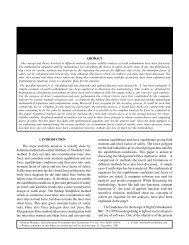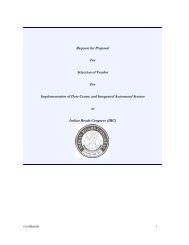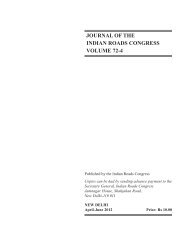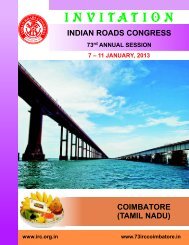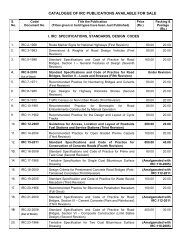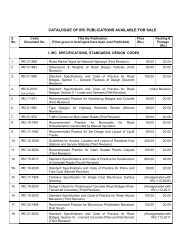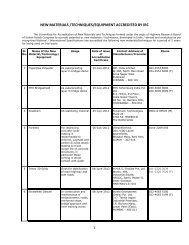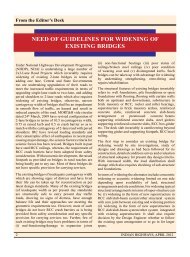Design and Construction of Pre-Tensioned Sutlej Bridge in Punjab
Design and Construction of Pre-Tensioned Sutlej Bridge in Punjab
Design and Construction of Pre-Tensioned Sutlej Bridge in Punjab
Create successful ePaper yourself
Turn your PDF publications into a flip-book with our unique Google optimized e-Paper software.
148<br />
Though the aggregate s<strong>in</strong>k<strong>in</strong>g <strong>of</strong> 854 m was accomplished<br />
<strong>in</strong> a short period <strong>of</strong> 620 days, the good eng<strong>in</strong>eer<strong>in</strong>g practice <strong>of</strong><br />
fix<strong>in</strong>g the well cap at LWL/bed level, would have reduced the<br />
s<strong>in</strong>k<strong>in</strong>g duration, efforts <strong>and</strong> its f<strong>in</strong>ancial ramification quite<br />
considerably.<br />
At the every alternative well location, after reach<strong>in</strong>g the<br />
found<strong>in</strong>g level, the soil <strong>in</strong>vestigation was carried out up to 9 m<br />
depths to deduce ‘C’ <strong>and</strong> φ values to confirm the soil bear<strong>in</strong>g<br />
capacities. Bottom plugg<strong>in</strong>g was carried out by shift<strong>in</strong>g the<br />
concrete from batch<strong>in</strong>g plants through buckets <strong>and</strong> plac<strong>in</strong>g<br />
by tremie pipes. After hav<strong>in</strong>g done the recuperation test for<br />
soundness <strong>of</strong> plug after 14 days, the s<strong>and</strong> fill<strong>in</strong>g <strong>and</strong><br />
<strong>in</strong>termediate plugs were expedited. With the help <strong>of</strong><br />
irrecoverable shutter<strong>in</strong>g supported on precast beams <strong>and</strong><br />
c<strong>of</strong>ferdam, each well cap was completed with<strong>in</strong> five to six days<br />
<strong>in</strong>clud<strong>in</strong>g re<strong>in</strong>forcement fix<strong>in</strong>g <strong>and</strong> concret<strong>in</strong>g.<br />
5. PIERS<br />
The RCC piers were <strong>of</strong> wall type flar<strong>in</strong>g from well cap to<br />
accommodate the pier cap, with the concrete characteristic<br />
strength <strong>of</strong> 35 N/mm 2 . Though the grade <strong>of</strong> the concrete is<br />
same as that <strong>of</strong> used for well cap, the mix had to be made little<br />
richer with higher workability <strong>in</strong> order to enable smooth<br />
placement <strong>of</strong> concrete for the th<strong>in</strong> sections. A system <strong>of</strong><br />
formwork consist<strong>in</strong>g <strong>of</strong> steel channels <strong>and</strong> shutter<strong>in</strong>g was used<br />
<strong>in</strong> piers, which was concreted <strong>in</strong> two stages (Photo 4).<br />
Photo 4. Shutter<strong>in</strong>g Arrangement for Pier<br />
The height <strong>of</strong> the first lift was 3.25 m <strong>and</strong> after concret<strong>in</strong>g<br />
the first lift, the balance second lift shutter<strong>in</strong>g was fixed<br />
immediately <strong>in</strong> 3 to 5 hours. The grout leakage through the<br />
jo<strong>in</strong>ts <strong>of</strong> shutter<strong>in</strong>g was totally avoided by judicious plann<strong>in</strong>g<br />
dur<strong>in</strong>g the fabrication <strong>of</strong> shutter<strong>in</strong>g such as overlapp<strong>in</strong>g <strong>of</strong><br />
plates, etc. The concret<strong>in</strong>g for each lift was carried out <strong>in</strong><br />
cont<strong>in</strong>uous operation without the cold jo<strong>in</strong>t. By virtue <strong>of</strong> large<br />
shutter<strong>in</strong>g <strong>and</strong> m<strong>in</strong>imum number <strong>of</strong> lifts <strong>in</strong> concret<strong>in</strong>g, the surface<br />
texture <strong>of</strong> the concrete pier has been <strong>of</strong> excellent quality.<br />
6. SUPERSTRUCTURE<br />
6.1 Choice <strong>of</strong> Cross Section<br />
Due to the obvious advantages enumerated <strong>in</strong><br />
Conceptualisation Para, the an isotropic deck was considered<br />
HEGGADE, MEHTA & PRAKASH ON<br />
to be made up <strong>of</strong> 35.40 m long precast pretensioned beams,<br />
transversely held by 200 mm thick RCC deck slab. Though the<br />
design-wise <strong>and</strong> from aesthetical considerations, the<br />
<strong>in</strong>termediate diaphragms could have been avoided, the same<br />
has been provided to satisfy contractual requirement which<br />
are <strong>in</strong> fact structurally redundant.<br />
As there are no design criteria laid down <strong>in</strong> IRC st<strong>and</strong>ards<br />
for pretension<strong>in</strong>g, <strong>in</strong>variably IRC:18 meant for post-tensioned<br />
construction is adopted <strong>and</strong> <strong>in</strong>sisted upon, for pretension<br />
construction also. The present post-tensioned Code IRC:18<br />
prescribes work<strong>in</strong>g stress method <strong>of</strong> design <strong>and</strong> permissible<br />
stresses seem to be on highly conservative side. The<br />
comparable AASHTO-94, the st<strong>and</strong>ard that is also based on<br />
allowable stress method (ASD) design, allows at least 33 per<br />
cent higher flexural stresses dur<strong>in</strong>g transfer <strong>and</strong> 25 per cent<br />
higher flexural stresses dur<strong>in</strong>g service condition. To worsen<br />
the matter further, the ‘IRC’ stipulates 20 per cent additional<br />
time dependent losses, 3 times 1000 h relaxation losses, m<strong>in</strong>imum<br />
80 per cent <strong>of</strong> characteristic strength at full transfer <strong>of</strong> prestress,<br />
those perhaps are rationalised for post-tensioned construction<br />
on the basis <strong>of</strong> past experience, where prestress transfer is<br />
feasible <strong>in</strong> stages.<br />
Universally, though generally there are no separate codes<br />
for post-tension<strong>in</strong>g <strong>and</strong> pre-tension<strong>in</strong>g, the prestress<strong>in</strong>g code<br />
itself give separate design parameters such as time dependent<br />
loss parameters, permissible stresses <strong>and</strong> transmission length<br />
for pre-tension<strong>in</strong>g, etc. In view <strong>of</strong> this the author had suggested<br />
to IRC Code Mak<strong>in</strong>g Committee to make IRC: 18 a common<br />
code for prestressed concrete road bridges common for both<br />
pretensioned <strong>and</strong> post tensioned concrete with the separate<br />
design parameters wherever relevant <strong>and</strong> applicable, which is<br />
yet to be taken <strong>in</strong>to cognisance.<br />
Selection <strong>of</strong> the beam cross section for long span<br />
pretensioned girders warrants experience <strong>in</strong> field supervision,<br />
apart from theoretical aspects <strong>of</strong> prestressed concrete. It is<br />
expected that the optimum concrete section that is materially<br />
<strong>in</strong>fluenced by prestress<strong>in</strong>g force <strong>and</strong> load<strong>in</strong>g, is light for<br />
h<strong>and</strong>l<strong>in</strong>g <strong>and</strong> transportation, prestress<strong>in</strong>g operation <strong>and</strong><br />
concret<strong>in</strong>g friendly. The sizes <strong>of</strong> bottom <strong>and</strong> top flanges, the<br />
depth <strong>and</strong> width <strong>of</strong> web are required to be optimised on the<br />
basis <strong>of</strong> above constructability issues.<br />
The pressure l<strong>in</strong>e (resultant <strong>of</strong> stresses) <strong>in</strong> the prestressed<br />
concrete flexural member shifts its location with<strong>in</strong> the section<br />
upon the application <strong>of</strong> external loads. In simply supported<br />
beams at the midspan for service condition, the stress at the<br />
bottom-fibre is zero, i.e. no tension allowed as per codal<br />
provision. At the midspan pressure l<strong>in</strong>e is above the CG <strong>of</strong> the<br />
section, warrant<strong>in</strong>g the CG <strong>of</strong> the prestress<strong>in</strong>g force at a<br />
distance equivalent to moment divided by prestress<strong>in</strong>g force.<br />
Thus to cater for the compressive force by virtue <strong>of</strong> pressure<br />
l<strong>in</strong>e above the CG <strong>of</strong> section at the midspan, the top flange<br />
requirement is high, whereas nearly zero-stressed bottom fibre



